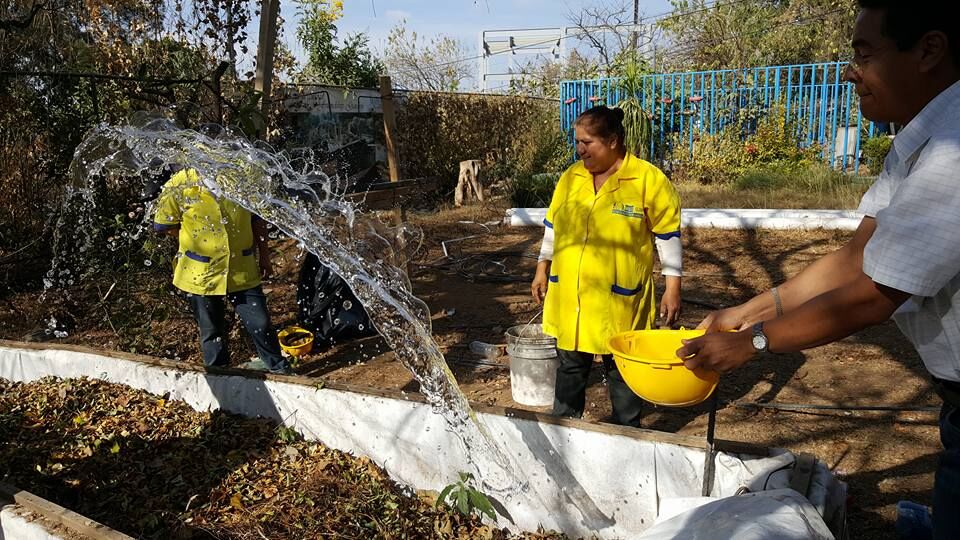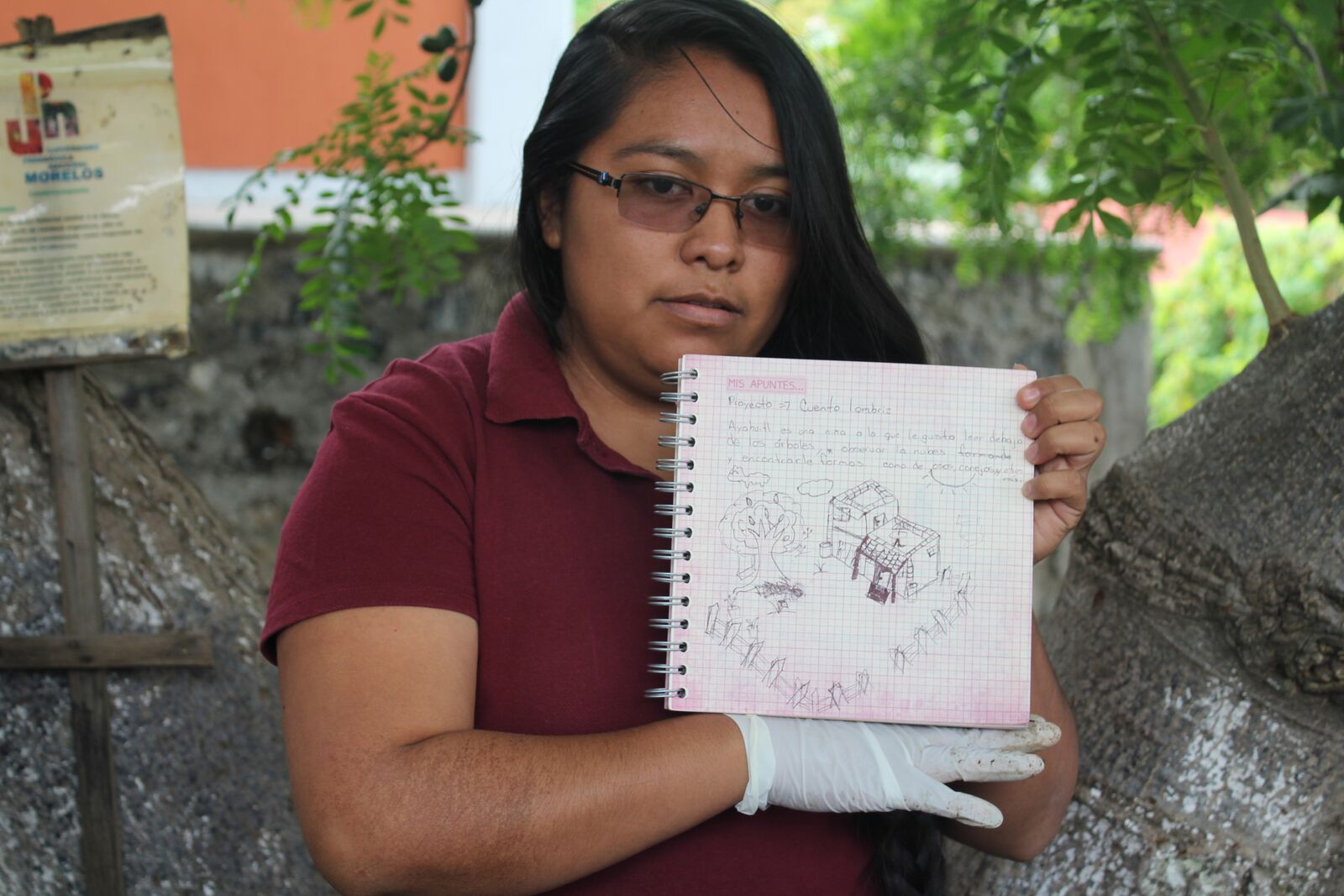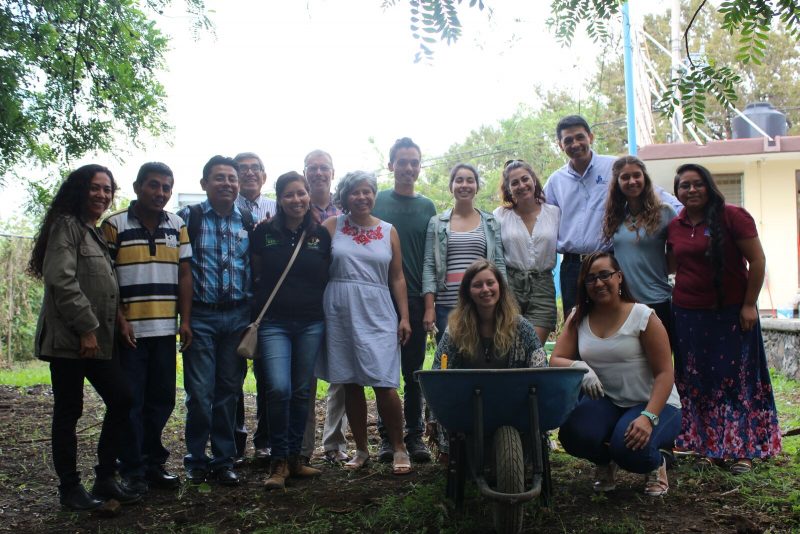Por Gisela Frías (Dawson College)
Un Plantel Educativo Sustentable se esmera en reducir la cantidad de desechos que produce y de manejarlos de una manera sustentable. La composta y la lombri-composta son un excelente método para rescatar los desechos orgánicos de la basura y hacerlos parte de un proceso de generación de abono que puede ser utilizado como sustituto parcial o total de fertilizantes químicos. La UPN Cuernavaca aceptó el desafío de ser un plantel educativo sustentable y en la institución ya hay una lombri-composta. Lo que es muy particular de este proyecto es quiénes están detrás de esta iniciativa, que les motiva a trabajar en su composta, lo que han aprendido y cómo esta composta está nutriendo no solo el suelo de la UPN si no también su práctica pedagógica.

La idea de hacer una lombri composta en la sede UPN Cuernavaca surgió como una respuesta a los Retos del proyecto Planteles Educativos Sustentables. Estudiantes de la Licenciatura en Educación Primaria para el Medio Indígena (LEPEPMI) aceptaron este reto y en colaboración con maestros y personal administrativo de la sede. Al comienzo tenían un proyecto ambicioso que contemplaba llegar a la comercialización de la composta. Poco a poco, por falta de tiempo o interés el grupo se fue haciendo cada vez más pequeño, hasta que quedó un grupo de unos tres estudiantes, un maestro y una persona del personal administrativo. Esta historia no termina ahí. Este pequeño grupo ha trabajado arduamente la composta. Juntos le dan trayendo material orgánico desde sus casas para así alimentar a las lombrices y el impacto de su dedicación está teniendo un impacto mucho más allá de las paredes de su sede.
¿Cuales han sido los impactos de la lombri composta? Primero que nada, cabe destacar que cada uno de los que hoy siguen involucrados en mantener la composta ha vivido un proceso de transformación. El trabajar y aprender sobre la composta les ha llevado a una mayor concientización sobre su entorno natural. Han adquirido conocimientos específicos sobre el compostaje y las lombrices en si, pero también han aprendido a verse como posibles partícipes de soluciones a las problemáticas ambientales que hoy vivimos. Además, la composta ha dado muchos frutos pedagógicos; uno de ellos fue el diseño de una mascota, Tlali, que en lengua Náhuatl significa tierra. Tlali, una lombriz que vive en una composta ya es una egresada de la UPN y se dedica a ensenarle a niños y adultos sobre cómo ella les puede ayudar a convertir sus desechos orgánicos en composta. Otro importante fruto es el trabajo de Noemi Moreno y Antonio Sarmina, estudiantes de LEPEMI, quienes han escrito un cuento que nos puede enseñar de una manera lúdica sobre la lombri composta.

Por si estos resultados no fuesen lo suficientes, también es importante destacar que la lombri-composta ha generado un valioso espacio para la convivencia. Cada uno de los que trabajan en su mantenimiento se refiere a este trabajo como una oportunidad de liberarse del estrés que se vive cada día como estudiante, profesor o personal administrativo.
Finalmente, se preguntarán si el impacto ambiental de esta lombri-composta es significativo. La respuesta es sí! Quienes la mantienen también han hecho su composta en sus casas y hoy, después de ya estar en funcionamiento por más de un año, han logrado que la cafetería de la sede se comprometa a enviar sus desechos orgánicos a la lombri-composta. Los cambios organizacionales no ocurren de un día para otro. Nuestras instituciones educativas resisten el cambio, sea este liderado desde arriba o impulsado desde abajo. El compromiso a ser una Plantel Educativo Sustentable es tareas de toda la comunidad educativa. He aquí un ejemplo de cómo un pequeño grupo de personas comprometidas pueden provocar grandes cambios.
Blog basado en encuesta a Raful Pineda (maestro), Lilia Ramírez Sánchez (personal administrativo), Noemi Moreno y Antonio Sarmina (estudiantes LEPEPMI)
Vermicompost, nourishing the soil and ideas
By Gisela Frías (Dawson College) Translated by Abril Obregon
A sustainable campus works with dedication to reduce the quantity of waste that it produces and in managing it in a sustainable way. Composting and vermi-composting are excellent ways to transform organic waste into soil, making this waste be part of a compost generation process can lead to use it as a partial or total substitute of chemical fertilizers. The UPN Cuernavaca accepted the challenge of being a sustainable campus and now they have a vermicompost in the institution. What is particular about this project is who is behind this initiative, what motivates them to work on their compost, what they have learned and how this compost is not only nourishing the soil of the UPN but also their pedagogical practice.

The idea of composting in the UPN Cuernavaca campus emerged as an answer to the Sustainable Campuses Initiative. Students from the Primary Education for the Indigenous Environment (LEPEPMI) program with the collaboration of teachers and administrative staff accepted the challenge to work on becoming more sustainable. At the beginning, they had an ambitious project that contemplated the idea to commercialize compost. Little by little however, because of lack of time or interest in the project, the group became smaller, until only a group of three students, a teacher and a someone part of the administrative staff were left. The story did not end here. This small group has been working very hard on the compost. Together, they bring organic material from their homes to feed the worms and the impact of their dedication goes further than the walls of their campus.
What have been the impacts of the vermicompost? First of all, it is important to point out that each one of the participants who are still involved in maintaining the compost has lived a transformative process. Working and learning about the compost has sensitized them to their natural surroundings. They have acquired specific knowledge about compost and worms but they have also learned to see themselves as participants of the solutions to the environmental problems we live today. Furthermore, the compost has given many pedagogical results. One of them, was the design of a mascot, Tlali, that means earth in the Náhuatl language. Tlali, a worm that lives in the compost has traveled outside of the UNP and teaches kids and adults how she can help them transform their organic waste into compost. Another important result is the work of Noemi Moreno and Antonio Sarmina, students of the LEPEMI program, who have written a story that can teach us in a fun way about vermicomposting.

As if these results were not enough, it is also important to point out that vermicomposting has generated a valuable space for conviviality. Each one of the participants that works on its maintenance, refers to their work as an opportunity to free themselves from the stress they live every day as students, teachers or administrative staff.
Finally, you might wonder if the ecological impact of the vermicompost is actually significant. The answer is yes! The participants are also composting in their houses and today, after functioning for over a year, they have been able to get the cafeteria of the campus to commit to sending their organic waste to the vermicompost. Organizational changes do not happen from one day to another. Our educational institutions resist change, while it is being led from above or pushed from the bottom. The commitment to become a sustainable campus is a task that involves the whole educational community. Here is an example of how an involved, small group of people can bring about important changes.
Blog based on a survey of Raful Pineda (teacher), Lilia Ramírez Sánchez (administrative staff member), Noemi Moreno and Antonio Sarmina (LEPEPMI students).



